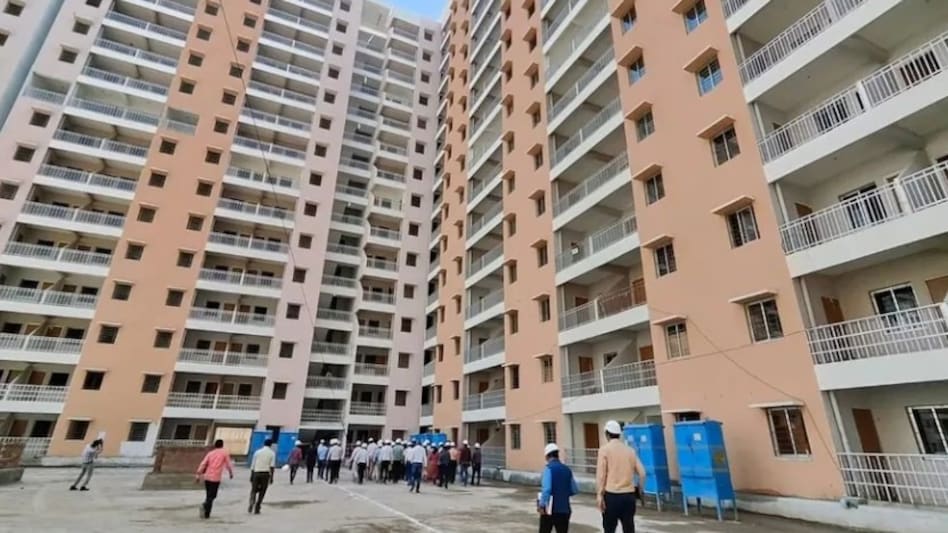Buying a home is becoming a distant dream for middle-class people in Delhi-NCR. Property rates were already skyrocketing, and now according to a new report, prices have increased by about 24 percent between July and September. This is significantly higher compared to other metro cities in the country. Why are property rates rising so rapidly in Delhi-NCR?
A major reason for the increase in property prices is the growing demand for luxury and premium homes. Buyers are now not just looking for investment, but also for a better lifestyle and modern amenities. Strong demand in this segment has impacted the demand for affordable homes.
Rapid Development in NCR
Meanwhile, infrastructure projects in Delhi-NCR are developing rapidly, which has turned many areas into real estate hotspots. For example, projects like the Dwarka Expressway have improved connectivity in surrounding areas, leading to a massive surge in property prices. In key markets like Gurugram, Noida, Greater Noida, and Ghaziabad, the expansion of better roads, metro networks, and other civic amenities has boosted demand. Furthermore, property prices in areas adjacent to the upcoming Noida Airport have risen rapidly. Property rates here have multiplied over the past 5 years and will increase further once the airport becomes operational.
Circle Rates Set to Increase in Delhi
The Delhi government is planning a revision of circle rates. The government aims to align circle rates with market rates, as the last major change occurred in 2014. The potential increase in circle rates has also created upward pressure on property prices in the market.
Meanwhile, after the COVID-19 period, people’s inclination to invest in real estate has increased. In many areas, buying property is yielding higher returns compared to rental income. This factor is also driving up demand and prices.
Situation in Other Cities Across the Country
According to data, the average price of residential property in Delhi-NCR increased from ₹7,200 per square foot a year ago to ₹8,900 per square foot during the July-September quarter. In Bengaluru, prices rose by 10% from ₹8,100 per square foot to ₹8,870 per square foot. Overall, across seven major cities, housing prices saw a 9% increase, rising from ₹8,390 per square foot to ₹9,105 per square foot.
The Mumbai Metropolitan Region (MMR) remained the most expensive residential market. Housing prices in MMR increased by 6%, from ₹16,300 per square foot to ₹17,230 per square foot. In Pune, residential property prices saw a 4% increase, from ₹7,600 per square foot to ₹7,935 per square foot.
Delhi-NCR
Delhi-NCR (National Capital Region) is a vast metropolitan area centered around New Delhi, India’s capital, encompassing satellite cities in neighboring states. Its history is deeply layered, with the modern capital of New Delhi being built adjacent to the historic old city of Delhi, which itself has been the site of seven previous capital cities dating back centuries. This makes the region a unique blend of ancient monuments, Mughal-era architecture, and modern urban development.
Dwarka Expressway
The Dwarka Expressway is a major infrastructure project in India, connecting Delhi to Gurugram in Haryana. It was conceived to decongest the heavily trafficked NH-48 and has become a significant catalyst for real estate development in the region. Its history is recent, with construction progressing through the 2010s and 2020s to address the growing connectivity needs of the National Capital Region (NCR).
Gurugram
Gurugram, formerly known as Gurgaon, is a major financial and technology hub located in the Indian state of Haryana, bordering New Delhi. Historically an agricultural town, its modern transformation began in the 1970s when Maruti Suzuki established a manufacturing plant there. Since then, it has experienced explosive growth, becoming a center for multinational corporations, luxury apartments, and shopping malls.
Noida
Noida is a planned city in the Indian state of Uttar Pradesh, established in 1976 as part of an urbanization initiative to decongest Delhi. It has rapidly transformed from agricultural land into a major hub for IT companies, multinational corporations, and educational institutions. The city’s name is an acronym for “New Okhla Industrial Development Authority,” reflecting its original purpose as an industrial township.
Greater Noida
Greater Noida is a planned city located in the Indian state of Uttar Pradesh, developed as an extension of the Noida region. It was established in the 1990s by the state government to decongest Delhi and support the industrial and residential growth of the National Capital Region (NCR). Today, it is known for its modern infrastructure, educational institutions, and as a hub for IT and manufacturing industries.
Ghaziabad
Ghaziabad is an industrial city in the Indian state of Uttar Pradesh, located near the national capital of New Delhi. It was founded in 1740 by Ghazi-ud-din, a Vizier of the Mughal Empire, and was originally a small fortress town. The city grew rapidly after the construction of the railway line in the 19th century, transforming into a major industrial and logistics hub.
Noida Airport
Noida International Airport, also known as Jewar Airport, is a new international airport currently under construction in the Jewar area of Uttar Pradesh, India. It is being developed to serve the National Capital Region (NCR) and is set to become one of the largest airports in India upon completion. The project was initiated to decongest the existing Indira Gandhi International Airport in Delhi and is being built in multiple phases, with the first phase expected to open in 2024.
Mumbai Metropolitan Region
The Mumbai Metropolitan Region is India’s largest metropolitan area, centered around the coastal megacity of Mumbai. Historically, it grew from a group of seven islands that were developed into a major port by the British East India Company in the 17th and 18th centuries. Today, it is the country’s primary financial, commercial, and entertainment hub, encompassing a vast network of satellite cities and suburbs.




